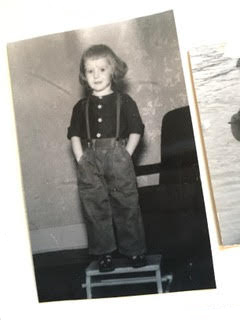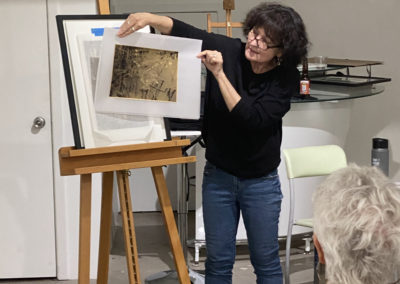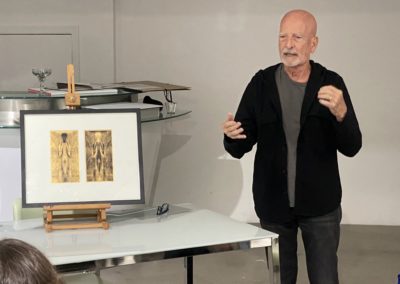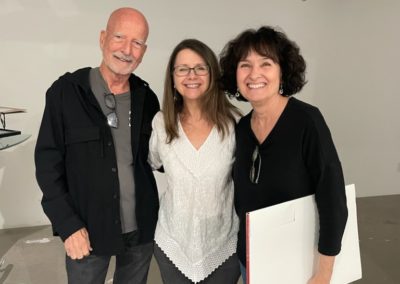Thanks to Dennis Collins who planned the event and Dean Terasaki who did the introductions at the beginning of the presentation, over 25 members of Arizona Photography Alliance gathered in the Mood Room Gallery at 3121 North Third Avenue on Saturday evening to celebrate the work of three artists as they answered the question: “Why do we go down that rabbit hole?” AZPA members Cyd Peroni, Nancy Miiller and Dennis Collins gave a casual presentation of their work (all three currently use translucent or transparent substrates), talked about what led them to it, and why they do what they do.
Beginning with Cyd Peroni, three questions came to her. Why does she make art, why does she use translucent material, and even more curious…why gold? Cyd told the crowd she loves sharing what she has seen with others, which completes a circle for her, and for many artists. Cyd also shared her love for the poetry of Mary Oliver (1935-2019) whose clear and poignant observations of the natural world continues to inspire her to make art. The Japanese philosophy called mono no aware (not clearly translated but refers to the bittersweet understanding of the ephemeral nature of all things) is often the subject of her photographs. Cyd began her career in printing where she discovered translucent paper and saw it as a way to play with light and watch its interaction with the image. “I view it as a veil and have come to see it as a way our life experiences affect how we see the world.” Quoting her favorite poet, she read a portion of Snow Geese:
“The geese flew on, I have never seen them again. Maybe I will, someday, somewhere. Maybe I won’t. It doesn’t matter. What matters is that, when I saw them, I saw them as through the veil, secretly, joyfully, clearly.”
Cyd shared several prints showing an evolution of her work, including the start of her Water Bearer series where she is experimenting with the use of color and self-portraiture. It is subtle work, and after 25 years, she continues to grow.
Photographer Nancy Miiller told everyone that the question ‘Why’ was daunting to her and stressed her out. It wasn’t until she slowed down and relaxed that the simple answer became clear. She began painting at nine years of age and has been making art ever since. “I’ve always been a creative person. I paint, sew, cook, photograph, and design,” she says. Nancy finds that the pandemic really allowed her a period for meditation and reflection. She also has a love for the ephemeral.
She shared the newest pieces from her Luminance portfolio with the group. In this series, she is using vellum paper backed with gesso to bring out a “luminance” of light and shadow to her in-camera double exposures. She finds the combination adds not only a luminescence, but a three-dimensional quality to her work.
Nancy showed several of her in-camera double exposures. The intricate botanicals backed with gesso brought out the play of light and shadow to each piece, which she hopes expresses the spiritual journey of darkness to light. As she points out, capturing a moment in time that will never be repeated is at once the most important thing about the work. Nancy’s photographs have been featured recently in LensWork magazine. She has shown locally at Art Intersection in Gilbert and will be one of the exhibiting artists in Artlink’s 22nd Annual Juried Exhibition in November.
Dennis Collins wrapped up the evening sharing that he has found inspiration from both Cyd and Nancy and with that inspiration, “I tried to create something of my own.” Instead of translucent paper, he has been using a transparent substrate normally used for making digital negatives (Pictorico) on which to print his photographs. He backs the transparent Pictorico with gold, and says he is selective when it comes to using the metal on his images.
He is drawn to subjects that reflect age and decay, again the transitory nature of objects, like those found in the cemeteries of New Orleans. He loves finding images that reveal ‘time’ through moss and deterioration. He dreams of visiting Scotland to photograph old cemeteries. Dennis mentioned flipping through Instagram one day where he found the post of a man who tours people through Scotland. He learned that prior to writing epitaphs on cemetery plots, the dead were often buried with a symbol carved into their headstones revealing what they had done in life, i.e., a shoe for a shoemaker. His dream is to be able to see these cemeteries in person.
To everyone’s amusement, Dennis revealed to all that he is so moved by someone who has a reaction to his work that he would, “gladly give the photograph to them!” We’ll all be in line, Dennis! He also shared many finished pieces as well as some showing the stages of the process, passing them around to the audience. He explained that he was once inspired by work he saw at the DIA in Detroit and went home to experiment on his own. “I did everything ‘wrong’ on purpose, but my prints came out beautifully!” His lesson: not to be afraid to experiment.
Thanks again to Dean Terasaki for introducing the speakers. President Neil Miller thanked Dennis Collins for arranging the program including the invitation to participants and setting up the evening for members. Thanks again Dennis! The evening was a great success, and we thank all three photographers for taking the time to share their inspirations, philosophies, and works with us.
Thanks to Dennis Collins who planned the event and Dean Terasaki who did the introductions at the beginning of the presentation, over 25 members of Arizona Photography Alliance gathered in the Mood Room Gallery at 3121 North Third Avenue on Saturday evening to celebrate the work of three artists as they answered the question: ‘Why’ do we go down that rabbit hole?” AZPA members Cyd Peroni, Nancy Miiller and Dennis Collins gave a casual presentation of their work (all three currently use translucent or transparent substrates), talked about what lead them to it, and why they do what they do.
Beginning with Cyd Peroni, three questions came to her. Why does she make art, why does she use translucent material, and even more curious…why gold? Cyd told the crowd she loves sharing what she has seen with others, which completes a circle for her, and for many artists. Cyd also shared her love for the poetry of Mary Oliver (1935-2019) whose clear and poignant observations of the natural world continues to inspire her to make art. The Japanese philosophy called mono no aware (not clearly translated but refers to the bittersweet understanding of the ephemeral nature of all things) is often the subject of her photographs. Cyd began her career in printing where she discovered translucent paper and saw it as a way to play with light and watch its interaction with the image. “I view it as a veil and have come to see it as a way our life experiences affect how we see the world.” Quoting her favorite poet, she read a portion of Snow Geese:
“The geese flew on, I have never seen them again. Maybe I will, someday, somewhere. Maybe I won’t. It doesn’t matter. What matters is that, when I saw them, I saw them as through the veil, secretly, joyfully, clearly.”
Cyd shared several prints showing an evolution of her work, including the start of her Water Bearer series where she is experimenting with the use of color and self-portraiture. It is subtle work, and after 25 years, she continues to grow.
Photographer Nancy Miiller told everyone that the question ‘Why’ was daunting to her and stressed her out. It wasn’t until she slowed down and relaxed that the simple answer became clear. She began painting at nine years of age and has been making art ever since. “I’ve always been a creative person. I paint, sew, cook, photograph, and design,” she says. Nancy finds that the pandemic really allowed her a period for meditation and reflection. She also has a love for the ephemeral.
She shared the newest pieces from her Luminance portfolio with the group. In this series, she is using vellum paper backed with gesso to bring out a luminance of light and shadow to her in-camera double exposures. She finds the combination adds not only a luminance, but a three-dimensional quality to her work.
Nancy showed several of her in-camera double exposures. The intricate botanicals backed with gesso brought out the play of light and shadow to each piece, which she hopes expresses the spiritual journey of darkness to light. As she points out, capturing a moment in time that will never be repeated is at once the most important thing about the work. Nancy’s photographs have been featured recently in LensWork magazine. She has shown locally at Art Intersection in Gilbert and will be one of the exhibiting artists in Artlink’s 22nd Annual Juried Exhibition in November.
Dennis Collins wrapped up the evening sharing that he has found inspiration from both Cyd and Nancy and with that inspiration, “I tried to create something of my own.” Instead of translucent paper, he has been using a transparent substrate normally used for making digital negatives (Pictorico) on which to print his photographs. He backs the transparent Pictorico with gold, and says he is selective when it comes to using the metal on his images.
He is drawn to subjects that reflect age and decay, again the transitory nature of objects, like those found in the cemeteries of New Orleans. He loves finding images that reveal ‘time’ through moss and deterioration. He dreams of visiting Scotland to photograph old cemeteries. Dennis mentioned flipping through Instagram one day where he found the post of a man who tours people through Scotland. He learned that prior to writing epitaphs on cemetery plots, the dead were often buried with a symbol carved into their headstones revealing what they had done in life, i.e., a shoe for a shoemaker. His dream is to be able to see these cemeteries in person.
To everyone’s amusement, Dennis revealed to all that he is so moved by someone who has a reaction to his work that he would, “gladly give the photograph to them!” We’ll all be in line Dennis! He also shared many finished pieces as well as some showing the stages of the process, passing them around to the audience. He explained that he was once inspired by work he saw at the DIA in Detroit and went home to experiment on his own. “I did everything ‘wrong’ on purpose, but my prints came out beautifully!” His lesson: not to be afraid to experiment.
Thanks again to Dean Terasaki for introducing the speakers. President Neil Miller thanked Dennis Collins for arranging the program including the invitation to participants and setting up the evening for members. Thanks again Dennis! The evening was a great success, and we thank all three photographers for taking the time to share their inspirations, philosophies, and works with us.

Linda Ballinger
Contributing Writer
Linda first became interested in photography as a five-year-old when she saw ‘upside down’ people in her grandfather’s camera. As a student at A.S.U. she earned her MA in Art History where she enjoyed photo classes with Bill Jenkins and photo history with Bill Jay. One serendipitous moment, sitting on the floor of Northlight Gallery, stapling burlap to a chair rail in an attempt to recreate 291 for a Steiglitz and his Circle class, she met a great friend, Jack Stuler. Jack Stuler’s devotion to his craft and students ignited Linda’s love for photography that has lasted decades. She was on the original founding board of InFocus at Phoenix Art Museum and she and her husband Jim, have been members of Arizona Photography Alliance since its inception.





